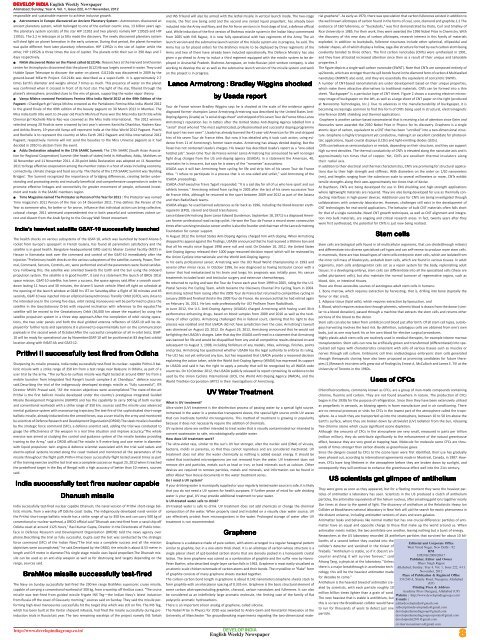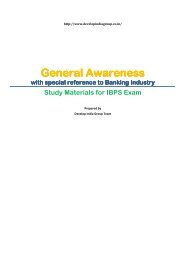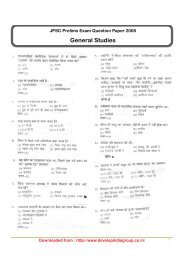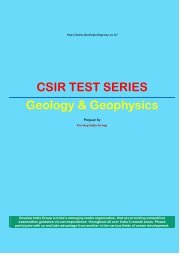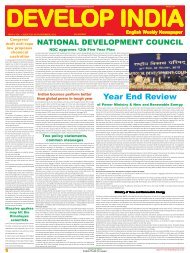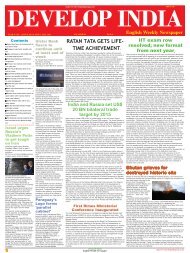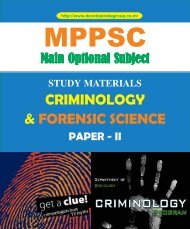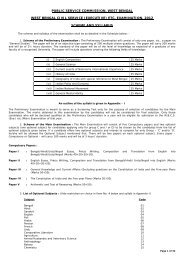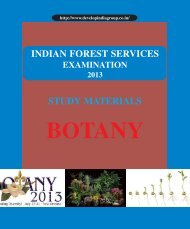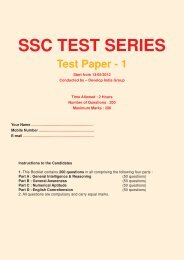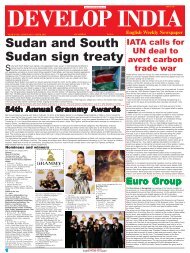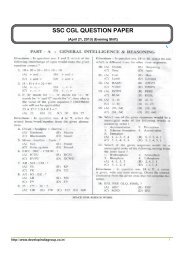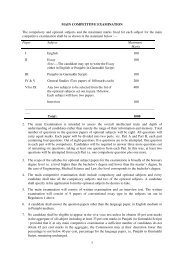Develop India Year 4, Vol. 1, Issue 222, 4-11 November, 2012.pmd
Develop India Year 4, Vol. 1, Issue 222, 4-11 November, 2012.pmd
Develop India Year 4, Vol. 1, Issue 222, 4-11 November, 2012.pmd
You also want an ePaper? Increase the reach of your titles
YUMPU automatically turns print PDFs into web optimized ePapers that Google loves.
DEVELOP INDIA English Weekly Newspaper<br />
Allahabad; Sunday; <strong>Year</strong> 4, <strong>Vol</strong>. 1, <strong>Issue</strong> <strong>222</strong>, 4-<strong>11</strong> <strong>November</strong>, 2012<br />
responsible and sustainable manner to achieve inclusive growth.<br />
● Astronomers in Europe discovered an Ancient Planetary System : Astronomers discovered an<br />
ancient planetary system, which belonged to one of the earliest cosmic eras, 13 billion years ago.<br />
The planetary system consists of the star HIP <strong>11</strong>952 and two planets namely HIP <strong>11</strong>952b and HIP<br />
<strong>11</strong>952c. The 2.2 m telescope at La Silla made the discovery. The newly discovered planetary system<br />
will shed light on planet formation in the early universe. During that period, the planet formation<br />
was quite different from later planetary information. HIP <strong>11</strong>952c is the size of Jupiter while the<br />
other, HIP <strong>11</strong>952b is three times the size of Jupiter. The planets orbit their sun in 290 days and 7<br />
days respectively.<br />
● NASA discovered Water on the Planet called GJ1214b : Researchers at the Harvard Smithsonian<br />
centre for Astrophysics discovered that the planet GJ1214b was largely covered in water. They used<br />
Hubble Space Telescope to discover the water on planet. GJ1214b was discovered in 2009 by the<br />
ground-based MEarth Project. GJ1214b was described as a super-Earth. It is approximately 2.7<br />
times Earth’s diameter and weighs almost 7 times as much. This presence of water on the planet<br />
was confirmed when it crossed in front of its host star. The light of the star, filtered through the<br />
planet’s atmosphere, provided clues to the mix of gasses, supporting the water vapor theory.<br />
● Vanya Mishra crowned Pantaloons Femina Miss <strong>India</strong> World 2012 at the 49th Edition of the<br />
Pageant : Chandigarh girl Vanya Mishra crowned as the Pantaloons Femina Miss <strong>India</strong> World 2012<br />
in the grand finale of the 49th edition of the beauty pageant on 30 March 2012 in Mumbai. The<br />
Miss <strong>India</strong> Earth title went to 24-year-old Prachi Mishra of Pune won the Miss <strong>India</strong> Earth title while<br />
Chennai girl Rochelle Maria Rao was crowned as the Miss <strong>India</strong> International. The 2012 winners<br />
selected among 20 finalists were crowned by last year’s winners Kanistha Dhankhar, Hasleen Kaur<br />
and Ankita Shorey. 19-year-old Vanya will represent <strong>India</strong> at the Miss World 2012 Pageant. Prachi<br />
and Rochelle is to represent the country at Miss Earth 2012 Pageant and Miss International 2012<br />
Pageant, respectively. Femina will not send the beauties to the Miss Universe pageant as it had<br />
decided in 2010 to abstain from the event.<br />
● Addu Declaration adopted in the 17th SAARC Summit: The 17th SAARC (South Asian Association<br />
for Regional Cooperation) Summit (the heads of states) held in Hithadhoo, Addu, Maldives on<br />
10 <strong>November</strong> and <strong>11</strong> <strong>November</strong> 20<strong>11</strong>. A 20-point Addu Declaration was adopted on <strong>11</strong> <strong>November</strong><br />
20<strong>11</strong> to forge effective cooperation among the member states in a host of areas including economy,<br />
connectivity, climate change and food security. The theme of the 17th SAARC Summit was ‘Building<br />
Bridges’. The Summit recognized the importance of bridging differences, creating better understanding<br />
and promoting amity and mutually beneficial and comprehensive cooperation in order to<br />
promote effective linkages and connectivity for greater movement of people, enhanced investment<br />
and trade in the SAARC members region.<br />
● Time Magazine named The Protester as Person of the <strong>Year</strong> for 20<strong>11</strong> : The Protester was named<br />
Time magazine’s 20<strong>11</strong> Person of the <strong>Year</strong> on 14 December 20<strong>11</strong>. Time defines the Person of the<br />
<strong>Year</strong> as someone who, for better or for worse, influence that individual action can bring collective,<br />
colossal change. 20<strong>11</strong> witnessed unprecedented rise in both peaceful and sometimes violent unrest<br />
and dissent from the Arab Spring to the Occupy Wall Street movement.<br />
<strong>India</strong>’s heaviest satellite GSAT-10 successfully launched<br />
The health checks on various subsystems of the GSAT-10, which was launched by board Ariane-5<br />
rocket from Europe’s spaceport in French Guiana, has found all parameters satisfactory and the<br />
satellite is in good health. Bangalore-headquartered ISRO said its Master Control Facility (MCF) in<br />
Hassan in Karnataka took over the command and control of the GSAT-10 immediately after the<br />
injection.”Preliminary health checks on the various subsystems of the satellite, namely, Power, Thermal,<br />
Command, Sensors, Controls, etc, were performed and all the parameters were found satisfactory.<br />
Following this, the satellite was oriented towards the Earth and the Sun using the onboard<br />
propulsion system. The satellite is in good health”, it said in a statement.The launch of ISROs 101st<br />
space mission, GSAT-10 satellite, has been a success, the space agency said.After a smooth countdown<br />
lasting <strong>11</strong> hours and 30 minutes, the Ariane-5 launch vehicle lifted off right on schedule at<br />
the opening of the launch window at 0248 hrs IST on Saturday.After a flight of 30 minutes and 45<br />
seconds, GSAT-10 was injected into an elliptical Geosynchronous Transfer Orbit (GTO), very close to<br />
the intended one.In the coming five days, orbit raising manoeuvres will be performed to place the<br />
satellite in the Geostationary Orbit with required inclination with reference to the equator.The<br />
satellite will be moved to the Geostationary Orbit (36,000 km above the equator) by using the<br />
satellite propulsion system in a three step approach.After the completion of orbit raising operations,<br />
the two solar panels and both the dual gridded antenna reflectors of GSAT-10 will be deployed<br />
for further tests and operations.It is planned to experimentally turn on the communication<br />
payloads in the second week of October.After the successful completion of all in-orbit tests, GSAT-<br />
10 will be ready for operational use by <strong>November</strong>.GSAT-10 will be positioned at 83 deg East orbital<br />
location along with INSAT-4A and GSAT-12.<br />
Prithvi II successfully test fir<br />
ired from Odisha<br />
Sharpening its missile prowess, <strong>India</strong> today successfully test-fired its nuclear- capable Prithvi-II ballistic<br />
missile with a strike range of 350 km from a test range near Balasore in Odisha, as part of a<br />
user trial by the army. ”The surface-to-surface missile was flight tested at around 0907 hrs from a<br />
mobile launcher from Integrated Test Range’s launch complex-3 at Chandipur,” defence sources<br />
said.Describing the trial of the indigenously developed strategic missile as “fully successful”, ITR<br />
Director MVKV Prasad said, “All the mission objectives were accomplished.”The state-of-the-art<br />
Prithvi is the first ballistic missile developed under the country’s prestigious Integrated Guided<br />
Missile <strong>Develop</strong>ment Programme (IGMPD) and has the capability to carry 500 kg of both nuclear<br />
and conventional warheads with a strike range of 350 km, sources said.The missile uses advanced<br />
inertial guidance system with manoeuvring trajectory.The test-fire of the sophisticated short-range<br />
ballistic missile, already inducted into the armed forces, was a user trial by the army and monitored<br />
by scientists of Defence Research and <strong>Develop</strong>ment Organisation (DRDO).The sleek missile is handled<br />
by the strategic force command (SFC), a defence scientist said, adding the trial was conducted to<br />
gauge the effectiveness of the weapon in a real time situation and improve accuracy.”The whole<br />
exercise was aimed at studying the control and guidance system of the missile besides providing<br />
training to the Army,” said a DRDO official.The missile is 9 metre-long and one metre in diameter<br />
with liquid propulsion twin engine.A defence scientist associated with the trial said radars and<br />
electro-optical systems located along the coast tracked and monitored all the parameters of the<br />
missile throughout the flight path.Prithvi-II has been successfully flight tested several times as part<br />
of the training exercise and the last trial was a complete success on August 25, 2012 when it reached<br />
the predefined target in the Bay of Bengal with a high accuracy of better than 10 meters, sources<br />
said.<br />
<strong>India</strong> successfully test fir<br />
ires nuc<br />
uclear capa<br />
pable<br />
http://www.developindiagroup.co.in/<br />
Dhanush missile<br />
<strong>India</strong> successfully test-fired nuclear capable Dhanush, the naval version of Prithvi short-range ballistic<br />
missile, from a warship off Odisha coast today. The indigenously developed naval version of<br />
the Prithvi short-range ballistic missile has a strike range of up to 350 km and can carry 500 kg of<br />
conventional or nuclear warhead, a DRDO official said.”Dhanush was test-fired from a naval ship off<br />
Odisha coast at around <strong>11</strong>25 hours,” Ravi Kumar Gupta, Director in the Directorate of Public Interface<br />
in Defence Research and <strong>Develop</strong>ment Organisation (DRDO) told the news agency over<br />
phone.Describing the trial as fully successful, Gupta said the test was conducted by the strategic<br />
force command (SFC) of the <strong>India</strong>n Navy.”The trial was a complete success and all the mission<br />
objectives were accomplished,” he said.<strong>Develop</strong>ed by the DRDO, the missile is about 8.53 metre in<br />
length and 0.9 metre in diameter.This single stage missile uses liquid propellant.The Dhanush missile<br />
can be used as an anti-ship weapon as well as for destroying land targets depending on the<br />
range, sources said.<br />
BrahMos missile successfully test-fir<br />
ired<br />
The Navy on Sunday successfully test-fired the 290-km range BrahMos supersonic cruise missile,<br />
capable of carrying a conventional warhead of 300 kg, from a warship off theGoa coast. ”The cruise<br />
missile was test-fired from guided missile frigate INS Teg—the <strong>India</strong>n Navy’s latest induction<br />
from Russia off the coast of Goa early morning,” sources said on Sunday. They said the missile performing<br />
high-level manoeuvres successfully hit the target ship which was still on fire. The INS Teg,<br />
which has been built at the Yantar shipyard inRussia, had fired the missile successfully during preinduction<br />
trials in Russia last year. The two remaining warships of the project namely INS Tarkah<br />
and INS Trikand will also be armed with the lethal missile in vertical launch mode. The two-stage<br />
missile, the first one being solid and the second one ramjet liquid propellant, has already been<br />
inducted into the Army and Navy, and the Air Force version is in final stage of trial, a defence official<br />
said. While induction of the first version of Brahmos missile system in the <strong>India</strong>n Navy commenced<br />
from 2005 with INS Rajput, it is now fully operational with two regiments of the Army. The air<br />
launch version and the submarine launch version of the missile system are in progress, he said. The<br />
Army has so far placed orders for the Brahmos missile to be deployed by three regiments of the<br />
Army and two of them have already been inducted operationally. The Defence Ministry has also<br />
given a go-ahead to Army to induct a third regiment equipped with the missile system to be deployed<br />
in Arunachal Pradesh. Brahmos Aerospace, an Indo-Russian joint venture company, is also<br />
working to develop the air as well as the submarine launch version of the missile system and work<br />
on the project is in progress.<br />
Lance Armstrong : Bradle<br />
adley Wiggins gins shocked<br />
by Usada repor<br />
port<br />
Tour de France winner Bradley Wiggins says he is shocked at the scale of the evidence against<br />
disgraced former champion Lance Armstrong.Armstrong was described by the United States Anti-<br />
Doping Agency (Usada) as "a serial drugs cheat" and stripped of his seven Tour de France titles.Lance<br />
Armstrong's reputation lies in tatters after the United States Anti-Doping Agency labelled him a<br />
"serial" cheat who led "the most sophisticated, professionalised and successful doping programme<br />
that sport has ever seen". Usada has already banned the 41-year-old American for life and stripped<br />
him of his seven Tour de France titles. But now it has detailed why it took such action, using evidence<br />
from <strong>11</strong> of Armstrong's former team-mates. Armstrong has always denied doping. But the<br />
Texan has not contested Usada's charges. His lawyer has described Usada's report as a "one-sided<br />
hatchet job". Seven-time Tour de France winner Lance Armstrong has announced he will no longer<br />
fight drug charges from the US anti-doping agency (USADA). In a statement the American, 40,<br />
maintains he is innocent, but says he is weary of the "nonsense" accusations.<br />
USADA says it will ban Armstrong from cycling for life and strip him of his seven Tour de France<br />
titles. "I refuse to participate in a process that is so one-sided and unfair," said Armstrong of the<br />
USADA proceedings.<br />
USADA chief executive Travis Tygart responded: "It is a sad day for all of us who love sport and our<br />
athletic heroes." Armstrong retired from cycling in 2005 after the last of his seven successive Tour<br />
de France titles, although he returned to the sport between 2009 and 2012 as part of the Astana<br />
and then RadioShack teams.<br />
USADA alleges he used banned substances as far back as 1996, including the blood-booster erythropoietin<br />
(EPO), steroid and blood transfusions.<br />
Lance Edward Armstrong (born Lance Edward Gunderson, September 18, 1971) is a disgraced American<br />
former professional road racing cyclist. He won the Tour de France a record seven consecutive<br />
times after surviving testicular cancer and he is also the founder and chairman of the Lance Armstrong<br />
Foundation for cancer support.<br />
In August 2012 the United States Anti-Doping Agency charged him with doping. When Armstrong<br />
dropped his appeal against the findings, USADA announced that he had received a lifetime ban and<br />
that all his results since August 1998 were null and void. On October 10, 2012, the United States<br />
Anti-Doping Agency released their 1000 page reasoned decision report which will be reviewed by<br />
the Union Cycliste Internationale and the World Anti-Doping Agency.<br />
In his early professional career, Armstrong won the UCI Road World Championship in 1993 and<br />
several other minor races. In October 1996, he was diagnosed as having testicular cancer with a<br />
tumor that had metastasized to his brain and lungs; his prognosis was initially poor. His cancer<br />
treatments included brain and testicular surgery and extensive chemotherapy.<br />
He returned to cycling and won the Tour de France each year from 1999 to 2005, riding for the U.S.<br />
Postal Service Pro Cycling Team, which became the Discovery Channel Pro Cycling Team in 2004.<br />
Armstrong retired from racing after the 2005 Tour de France but returned to competitive cycling in<br />
January 2009 and finished third in the 2009 Tour de France. He announced that he had retired again<br />
on February 16, 20<strong>11</strong>. He last rode professionally for UCI ProTeam Team RadioShack.<br />
In June 2012, the U.S. Anti-Doping Agency (USADA) charged Armstrong with having used illicit<br />
performance enhancing drugs, based on blood samples from 2009 and 2010 as well as the testimony<br />
of other cyclists. Armstrong challenged this in federal court, claiming that his right to due<br />
process was violated and that USADA did not have jurisdiction over the case; Armstrong's lawsuit<br />
was dismissed on August 20, 2012. On August 23, 2012, Armstrong announced that he would not<br />
be fighting the USADA's charges. Later that day the USADA confirmed in a statement that Armstrong<br />
was banned for life and would be disqualified from any and all competitive results obtained on and<br />
subsequent to August 1, 1998, including forfeiture of any medals, titles, winnings, finishes, points<br />
and prizes. Armstrong has questioned whether USADA has the legal authority to enforce its ruling.<br />
The UCI has not yet enforced any ban, but has requested that USADA provide a reasoned decision<br />
explaining the action taken, while the World Anti-Doping Agency (WADA) has expressed its support<br />
to USADA and said it has the right to apply a penalty that will be recognized by all WADA code<br />
countries. On 10 October 2012, the USADA publicly released its report containing its evidence to be<br />
used by the Union Cycliste International (UCI), the World Anti-Doping Agency (WADA), and the<br />
World Triathlon Corporation (WTC) in their investigations of Armstrong.<br />
UV Water Trea<br />
eatment<br />
What is UV treatment?<br />
Ultra-violet (UV) treatment is the disinfection process of passing water by a special light source.<br />
Immersed in the water in a protective transparent sleeve, the special light source emits UV waves<br />
that can inactivate harmful microorganisms. This method of treatment is growing in popularity<br />
because it does not necessarily require the addition of chemicals.<br />
UV systems alone are neither intended to treat water that is visually contaminated nor intended to<br />
convert wastewater to safe, microbiologically potable water.<br />
How does UV treatment work?<br />
The ultra-violet rays, similar to the sun's UV but stronger, alter the nucleic acid (DNA) of viruses,<br />
bacteria, molds or parasites, so that they cannot reproduce and are considered inactivated. UV<br />
treatment does not alter the water chemically as nothing is added except energy. It should be<br />
noted that inactivated microorganisms are not removed from the water. UV treatment does not<br />
remove dirt and particles, metals such as lead or iron, or hard minerals such as calcium. Other<br />
devices are required to remove particles, metals and minerals, and information can be found in<br />
other About Your House documents in the water treatment series.<br />
Do I need a UV system?<br />
If your drinking water is municipally supplied or your regularly tested water source is safe, it is likely<br />
that you do not need a UV system for health purposes. If further peace of mind for safe drinking<br />
water is your goal, UV may provide additional treatment to your water.<br />
Is UV-treated water safe to drink?<br />
UV-treated water is safe to drink. UV treatment does not add chemicals or change the chemical<br />
composition of the water. When properly sized and installed on a visually clear water source, UV<br />
can effectively protect from microorganisms in the water. Prolonged storage of water after UV<br />
treatment is not recommended.<br />
Graphene<br />
Graphene is a substance made of pure carbon, with atoms arranged in a regular hexagonal pattern<br />
similar to graphite, but in a one-atom thick sheet. It is an allotrope of carbon whose structure is a<br />
single planar sheet of sp2-bonded carbon atoms that are densely packed in a honeycomb crystal<br />
lattice. The term graphene was coined as a combination of graphite and the suffix -ene by Hanns-<br />
Peter Boehm, who described single-layer carbon foils in 1962. Graphene is most easily visualized as<br />
an atomic-scale chicken wiremade of carbon atoms and their bonds. The crystalline or "flake" form<br />
of graphite consists of many graphene sheets stacked together.<br />
The carbon-carbon bond length in graphene is about 0.142 nanometers.Graphene sheets stack to<br />
form graphite with an interplanar spacing of 0.335 nm. Graphene is the basic structural element of<br />
some carbon allotropesincluding graphite, charcoal, carbon nanotubes and fullerenes. It can also<br />
be considered as an indefinitely large aromatic molecule, the limiting case of the family of flat<br />
polycyclic aromatic hydrocarbons.<br />
There is an important silicon analog of graphene, called silicene.<br />
The Nobel Prize in Physics for 2010 was awarded to Andre Geim and Konstantin Novoselov at the<br />
University of Manchester "for groundbreaking experiments regarding the two-dimensional material<br />
graphene". As early as 1970, there was speculation that carbon fullerenes existed in addition to<br />
the well known allotropes of carbon found in the forms of coal, soot, diamond and graphite.1,2 The<br />
existence of C60 fullerenes, or "buckyballs," was first demonstrated by Kroto, Curl and Smalley of<br />
Rice University in 1985. For their work, they were awarded the 1996 Nobel Prize in Chemistry. With<br />
the discovery of this new class of carbon allotropes, research interest in this family of materials<br />
exploded. In addition to buckyballs, fullerene structures include other spherical, ellipsoidal and<br />
tubular shapes, all of which display a hollow, cage-like structure formed by each carbon atom being<br />
covalently bonded to three others. The first carbon nanotubes (CNTs) were synthesized in 1991,<br />
and they have attracted increased attention since then as a result of their unique and tailorable<br />
properties.3<br />
The figure depicts a single-wall carbon nanotube (SWNT). Note that CNTs are composed entirely of<br />
sp2 bonds, which are stronger than the sp3 bonds found in the diamond form of carbon.4 Multiwalled<br />
nanotubes (MWNT) also exist, and they are essentially the equivalent of concentric SWNTs.<br />
A number of CNT-based nanomaterials are under development based on their unique properties,<br />
which make them attractive alternatives to traditional materials. CNTs can be formed into a thin<br />
sheet. "Buckypaper" is a particular type of CNT sheet. Figure 2 shows a scanning electron microscopy<br />
image of buckypaper on the left, as well as a large sheet of CNT paper on the right (produced<br />
at Nanocomp Technologies, Inc.). Due to advances in the manufacturability of buckypaper, it is<br />
becoming increasingly common to find this form of CNTs being used in structural, electromagnetic<br />
interference (EMI) shielding and thermal applications.<br />
Graphene is another carbon-based nanomaterial that is receiving a lot of attention since Geim and<br />
Novoselov were awarded the 2010 Nobel Prize in Physics for its discovery. Graphene is a single<br />
atomic layer of carbon, equivalent to a CNT that has been "unrolled" into a two-dimensional structure.<br />
Graphene is highly transparent yet conductive, making it an excellent candidate for photovoltaic<br />
applications, liquid crystal displays (LCDs) and light-emitting diodes (LEDs).<br />
CNTs can behave as semiconductors or metals, depending on their structure, and they can support<br />
high current densities. The thermal conductivity of CNTs is elevated along the nanotube axis and is<br />
approximately ten times that of copper. Yet, CNTs are excellent thermal insulators along<br />
their radial axis.<br />
In addition to their electrical and thermal characteristics, CNTs are promising for structural applications<br />
due to their high strength and stiffness. With diameters on the order on 1/10 nanometers<br />
(nm), and lengths ranging from the submicron scale to several millimeters or more, CNTs exhibit<br />
tensile strengths along their axes approximately ten times that of Kevlar.<br />
At Raytheon, CNTs are being developed for use in EMI shielding and high-strength applications<br />
where lightweight materials are required. They are also being developed for use as thermally conducting<br />
interfaces in high-power devices. Additional uses for CNTs are being investigated through<br />
collaborations with university laboratories. However, challenges still exist in the development of<br />
CNT technologies for real-world applications. The behavior of bulk CNT materials often falls short<br />
for that of a single nanotube. Novel CNT growth techniques, as well as CNT alignment and integration<br />
into bulk materials, are ongoing and critical research areas. In fact, twenty years after they<br />
were first synthesized, the potential for CNTs is just now being realized.<br />
Stem cells<br />
Stem cells are biological cells found in all multicellular organisms, that can divide(through mitosis)<br />
and differentiate into diverse specialized cell types and can self-renew to produce more stem cells.<br />
In mammals, there are two broad types of stem cells:embryonic stem cells, which are isolated from<br />
the inner cell mass of blastocysts, andadult stem cells, which are found in various tissues. In adult<br />
organisms, stem cells andprogenitor cells act as a repair system for the body, replenishing adult<br />
tissues. In a developing embryo, stem cells can differentiate into all the specialized cells (these are<br />
called pluripotent cells), but also maintain the normal turnover of regenerative organs, such as<br />
blood, skin, or intestinal tissues.<br />
There are three accessible sources of autologous adult stem cells in humans:<br />
1. Bone marrow, which requires extraction by harvesting, that is, drilling into bone (typically the<br />
femur or iliac crest),<br />
2. Adipose tissue (lipid cells), which requires extraction by liposuction, and<br />
3. Blood, which requires extraction through pheresis, wherein blood is drawn from the donor (similar<br />
to a blood donation), passed through a machine that extracts the stem cells and returns other<br />
portions of the blood to the donor.<br />
Stem cells can also be taken from umbilical cord blood just after birth. Of all stem cell types, autologous<br />
harvesting involves the least risk. By definition, autologous cells are obtained from one's own<br />
body, just as one may bank his or her own blood for elective surgical procedures.<br />
Highly plastic adult stem cells are routinely used in medical therapies, for example inbone marrow<br />
transplantation. Stem cells can now be artificially grown and transformed (differentiated) into specialized<br />
cell types with characteristics consistent with cells of various tissues such as muscles or<br />
nerves through cell culture. Embryonic cell lines andautologous embryonic stem cells generated<br />
through therapeutic cloning have also been proposed as promising candidates for future therapies.[1]<br />
Research into stem cells grew out of findings by Ernest A. McCulloch and James E. Till at the<br />
University of Toronto in the 1960s.<br />
Uses of CFCs<br />
Chlorofluorocarbons, commonly known as CFCs, are a group of man-made compounds containing<br />
chlorine, fluorine and carbon. They are not found anywhere in nature. The production of CFCs<br />
began in the 1930s for the purpose of refrigeration. Since then they have been extensively utilised<br />
as propellants in aerosols, as blowing agents in foam manufacture and in air conditioning. There<br />
are no removal processes or sinks for CFCs in the lowest part of the atmosphere called the troposphere.<br />
As a result they are transported up into the stratosphere, between 10 to 50 km above the<br />
Earth's surface, where they are broken down by ultraviolet (UV) radiation from the Sun, releasing<br />
free chlorine atoms which cause significant ozone depletion.<br />
Although the amounts of CFCs in the atmosphere are very small, measured in parts per trillion<br />
(million million), they do contribute significantly to the enhancement of the natural greenhouse<br />
effect, because they are very good at trapping heat. Molecule for molecule some CFCs are thousands<br />
of times stronger than carbon dioxide as greenhouse gases.<br />
Since the dangers caused by CFCs to the ozone layer were first identified, their use has gradually<br />
been phased out, according to international agreements made in Montreal, Canada, in 1987. However,<br />
CFCs have long lifetimes in the atmosphere before they are broken down by sunlight, and<br />
consequently they will continue to enhance the greenhouse effect well into the 21st century.<br />
US scientists get glimpse of antihelium<br />
They were gone as soon as they appeared, but for a fleeting moment they were the heaviest particles<br />
of antimatter a laboratory has seen. Scientists in the US produced a clutch of antihelium<br />
particles, the antimatter equivalents of the helium nucleus, after smashing gold ions together nearly<br />
1bn times at close to the speed of light. The discovery of antihelium at the Relativistic Heavy Ion<br />
Collider at Brookhaven national laboratory in New York will aid the search for exotic phenomena in<br />
the distant universe, including antimatter versions of stars and even galaxies.<br />
Antimatter looks and behaves like normal matter but has one crucial difference: particles of antimatter<br />
have an equal and opposite charge to those that make up the world around us. When<br />
antimatter meets matter, the two annihilate one another, leaving nothing but a burst of energy.<br />
Researchers at the US laboratory recorded 18 antihelium particles that survived for about 10 billionths<br />
of a second before they crashed into the<br />
collider's detector and vanished in the tiniest of<br />
fireballs. "Antihelium is stable, so if it doesn't encounter<br />
anything it will survive forever," said<br />
Aihong Tang, a physicist at the laboratory. "Unless<br />
there is a major breakthrough in accelerator technology,<br />
this will be the heaviest antimatter made<br />
for decades to come."<br />
Antihelium is the heaviest breed of antimatter created<br />
by scientists, with each particle roughly 10<br />
million billion times lighter than a grain of sand.<br />
The next heaviest that is stable is antilithium, but<br />
this is so rare the Brookhaven collider would have<br />
to run for thousands of years to detect just one<br />
particle.<br />
Editorial and Corporate Office<br />
West Vinod Nagar, New Delhi - 92<br />
RNI<br />
UPENG/2008/26617<br />
Publisher, Editor and Owner<br />
Dheer Singh Rajput<br />
Allahabad; Sunday; <strong>Year</strong> 4, <strong>Vol</strong>. 1, <strong>Issue</strong> <strong>222</strong>, 4-<strong>11</strong><br />
<strong>November</strong>, 2012<br />
Place of Publication & Registerd Office<br />
331/240 A, Stainly Road, Nayapura, Allahabad<br />
(UP)<br />
Printing Press & Address<br />
Academy Press Daraganj, Allahabad (UP)<br />
Website : http://www.developindiagroup.co.in/<br />
E-mails :<br />
editordevelopindia@gmail.com<br />
subscriptiondevelopindia@gmail.com<br />
developindiamediagroup@gmail.com<br />
developindiamediagroupcorporate@gmail.com<br />
developindia20<strong>11</strong>@gmail.com<br />
civilservicesminerva@gmail.com<br />
DEVELOP INDIA<br />
English Weekly Newspaper 8


